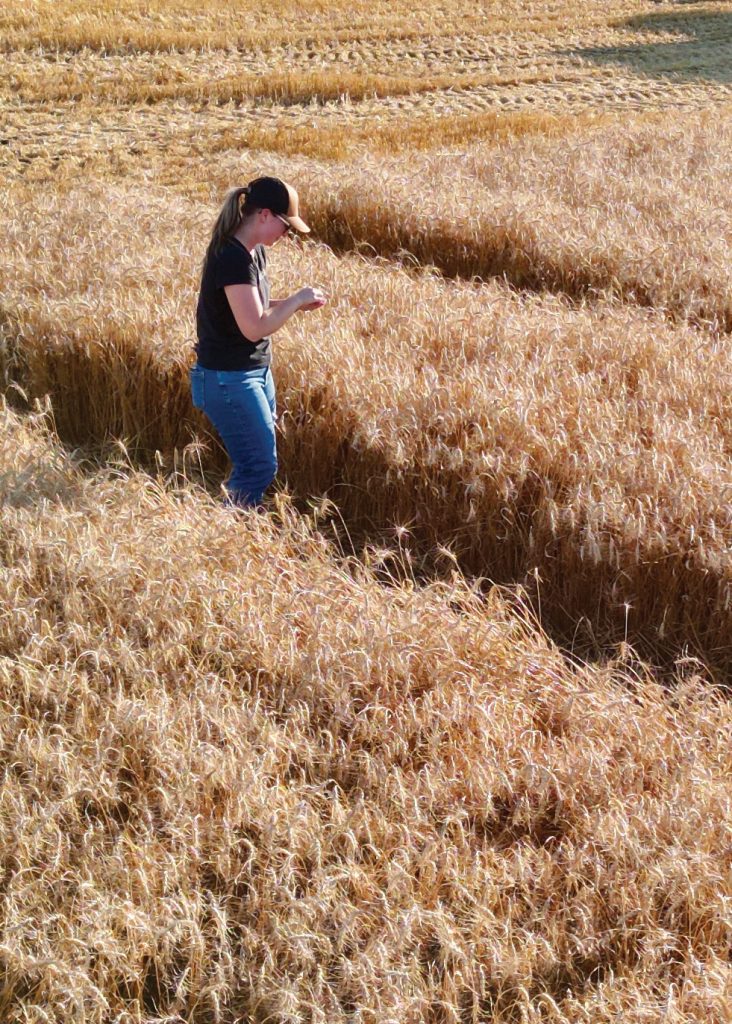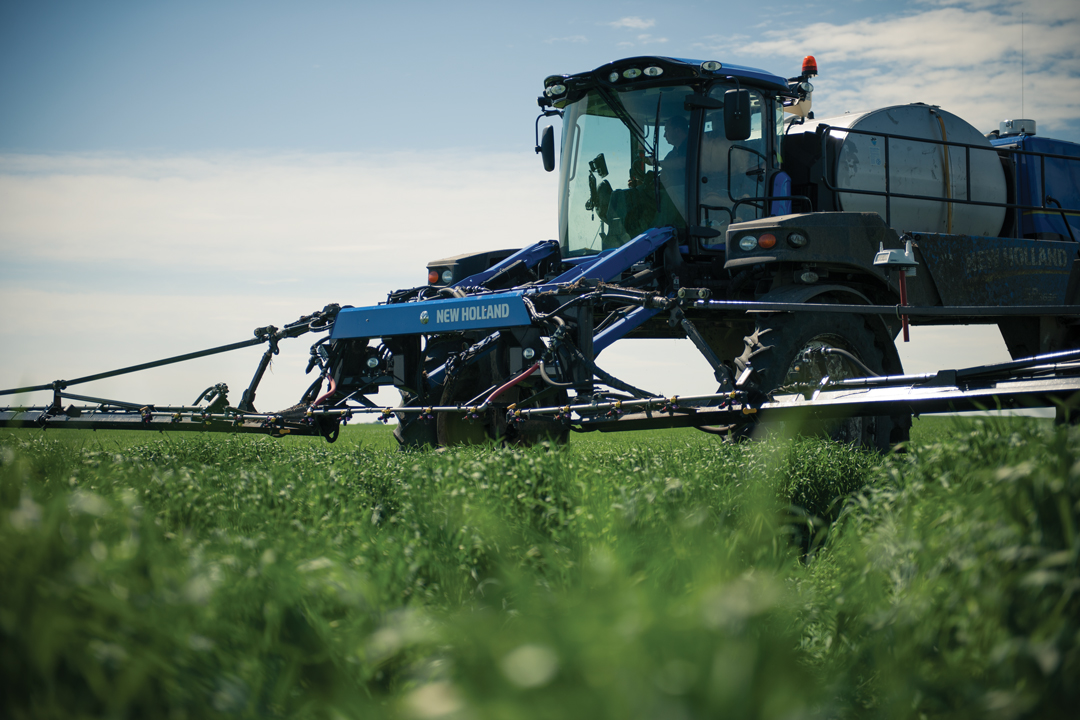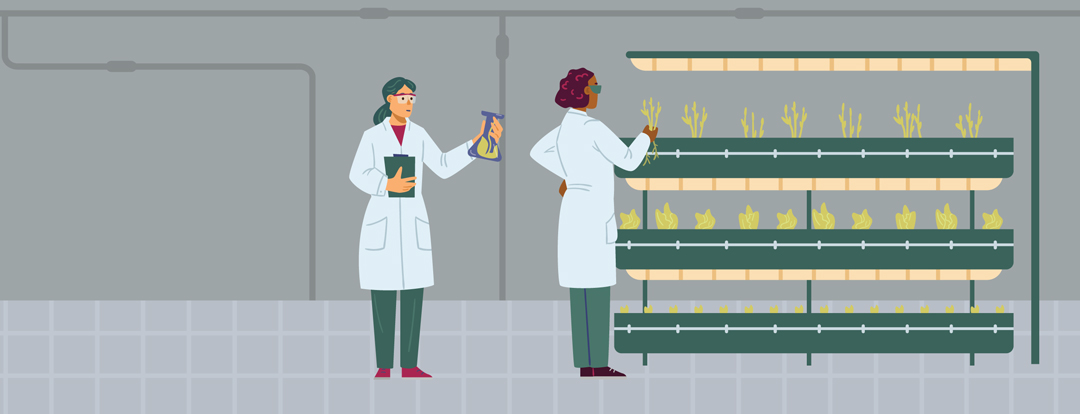PLENTY TO GAIN
BY MELANIE EPP • PHOTOS COURTESY OF ALBERTA GRAINS
The annual growth rate of Canadian agricultural productivity stood at or near two per cent from 1991 to 2010, according to a Farm Credit Canada (FCC) report released in December 2023. Since 2011, productivity growth has slowed and stands at just one per cent where it is projected to remain for the rest of this decade.
A Canadian Agri-Food Policy Institute (CAPI) report published in 2022 also addressed the issue. Both reports offer solutions to rekindle agricultural productivity growth and, as the FCC report suggests, boost net annual cash income for farmers by as much as $30 billion in the coming decade.
To make such gains, industry experts call for a multi-faceted approach that includes the adoption of new technology, improved efficiency and policy changes. This will significantly lift net cash income, they claim, as well as enhance food security and farm sustainability.
A HISTORY OF BIG GAINS
Simply put, agricultural productivity is the measure of goods and services produced relative to investments such as equipment, inputs and labour. According to FCC, between 1970 and 2020, the number of farms in Canada declined by half, average farm size doubled, value per acre nearly quadrupled and a farmer now produces twice as much with the same level of investment. This has been achieved with the adoption of new crop varieties, labour-saving technology and the use of big data in agronomic decision-making. Nonetheless, agricultural productivity growth has stalled.
One hypothesis is that the biggest, easiest gains were made long ago; the industry has picked the low-hanging fruit. “Producers have already adopted most of the technology that came in the ’90s and 2000s, such as low-till farming,” said Isaac Kwarteng, FCC senior economist. “The results have been impressive, so now the potential of growing productivity is limited.”
Productivity growth has also slowed due to a decline in investment in technology, he said. “When investment slows down, we don’t know where the next productivity drive is going to come from.”
It is possible to rekindle growth, said Kwarteng. Yield improvement could be achieved through the adoption of GPS-driven precision equipment, advanced seed varieties, improved irrigation technology and enhanced nutrient management practices such as the 4Rs. Mechanization and automation may also improve labour challenges.
Many farmers have adopted such technologies and management practices, yet others have not. According to a 2023 McKinsey & Company survey, European and North American farmers lead global ag-tech adoption. About 61 per cent of North American farmers now use or plan to use a new product in the next two years. Those surveyed also cited high costs (52 per cent) and unclear ROI (40 per cent) as barriers to adoption.
While lack of adoption has slowed productivity growth, so has lack of investment in research and development of new technology. Kwarteng said government should remedy this through the creation of public–private partnerships. Innovation in production practices can enhance resilience to climate change, expand food supply and boost the ratio of farm product prices to input costs paid by farmers, he added. The aforementioned $30 billion annual boost to the nation’s farm economy is a tantalizing potential reward.
“I think it is realistic, but challenging,” said Kwarteng. “We are optimistic that with the right investment in capital and technology, and with the adoption of modern farming practices aimed at enhancing efficiency, we should be able to realize these gains.”
The CAPI report, entitled Agri-Food Productivity and Trade: Policy Gaps and Possibilities, predicts a hungrier, hotter world full of geopolitical tensions where agricultural productivity growth struggles to meet demand. It recommends Canada monitor and potentially restrict acquisition of agri-food assets by foreign investors whose interests do not align with its own. It also suggests the country adjust policy to address the erosion of rules-based trade, which has enabled the use of agri-food trade as a “geo-economic weapon.” This includes sudden export bans, export taxes and strategic stockpiling that supports domestic prices and denies product to other nations.
Food is commonly used as a weapon in trade disputes, said Al Mussell, CAPI’s director of research and one of the report’s lead authors. For example, following the announcement of Canada’s tariffs on imports of Chinese electric vehicles and steel, China announced its launch of an anti-dumping investigation of Canadian canola exports. “It’s a way for countries potentially to intimidate one another economically,” he said. “Tariffs on farm and food products create impacts throughout agri-food supply chains and can have broadly felt effects.
A lot of these measures are precisely what the multilateral rules-based international trading system, the World Trade Organization and its various agreements, was designed to try and prevent.”
Such trade issues affect farm productivity when they restrict the marketplace. “In Canada, our agricultural production capacity vastly exceeds our domestic market needs in many products—grains, oilseeds, pork, beef, potatoes and some others,” said Mussell. “We need industry investment that will lead to productivity growth, and for that to happen we need reliable market access outside of Canada to sell our products.”
EFFECTIVE POLICY DRIVES INVESTMENT
A damaging knock-on effect of market uncertainty is its negative influence on private sector investment. Continued innovation in biologicals, crop protection products, precision application technology and variety development are critical to sustain productivity growth, said Pierre Petelle, president and CEO of CropLife Canada. Canadian farmers are poised and ready to adopt such innovations, he added.
“But a sometimes slow and unpredictable regulatory environment puts Canadian growers at a disadvantage when it comes to access to innovation next to some of its biggest competitors,” said Petelle. For example, delayed regulatory guidance slowed the use of gene editing for much-needed new variety development. “As growers continue to face changing climate conditions, new pest pressures and changing consumer demands, they need timely access to the latest crop varieties, and we need a regulatory environment that enables that.”
Petelle is similarly critical of regulatory impediments in crop protection. “If we are going to attract investment in new products, we need a regulatory environment that is clear, predictable and science-based,” he said.
While he recognizes the Pest Management Regulatory Agency’s (PMRA) strong global reputation as a science-based regulator, Petelle questioned the direction of the organization. He points to its transformation initiatives of the past three years as a distraction driven by politics that does not deliver benefits to Canadians or the agriculture sector. “We are seeing a worrying drop in the PMRA’s performance outcomes as a result.”
Canadian agriculture can drive economic growth in tandem with its own productivity, he said. Here again, he argued, the regulatory environment must enable this to happen.
Anthony Parker agrees. He is the Canadian Food Inspection Agency commissioner of plant breeders’ rights and Canada’s head delegate to the International Union for the Protection of New Varieties of Plants. Parker echoed Petelle’s call for conditions more conducive to growth. To secure investment in Canada’s agriculture sector requires the creation of a policies that incentivize and reward risk-taking and entrepreneurship.
Strong and effective intellectual property (IP) rights provide such an environment, he said. For example, plant breeders’ rights create a fair and level playing field where public entities, as well as small, medium and large companies can effectively compete in an open and free marketplace. “IP ownership is now the most valuable asset a business can own,” said Parker.
Industry and policymakers have long recognized IP rights’ ownership drives a knowledge-based economy, said Parker. The 2017 Barton report rung this bell almost a decade ago. A series of recommendations written by Dominic Barton, then-chair of the federal Advisory Council on Economic Growth, he envisioned a substantial increase in Canadian agricultural exports. Canada, Barton wrote, could become the world’s second-largest food exporter, up from fifth.
“Since the Barton Report, we have heard ongoing rhetoric about unleashing Canada’s potential to become an agriculture superpower,” said Parker. “Talk is great, action is better. We need to stop talking about our potential and start living up to it.” In January, CAPI called for the report to be updated. The entire industry, it said, has recently faced greater market volatility, which requires a new approach to risk management.
For the agriculture sector to live up to its potential does not require an overarching strategy, said Parker. “We all know what needs to be done. It simply requires moving forward, implementing concrete policies such as strengthened IP rights that will create a business and investment friendly environment in Canadian agriculture. Only then will we truly realize our potential and become an agriculture superpower.”
EXTENSION AND ADOPTION
Extension services enable farmers to learn, adapt, innovate and apply new technologies and practices that improve productivity. Yet, in 2020, Alberta Agriculture and Forestry extension services were slashed when 250 employees were laid off. “Every province has a different angle on ag extension,” said Mussell. “Alberta had the best farm management extension.” The industry continues to absorb the loss.
In a paper published in November 2023, John Knapp expressed similar concerns. Published after his term as deputy minister for Alberta Agriculture and Rural Development, the paper noted while private sector companies and NGOs have filled some extension needs, several areas are lacking. These include entomology, forage management practices, local marketing, new crops and startup food companies. “The exit of [the] Province as a significant role player in extension has left a vacuum in the system,” wrote Knapp.
Much of the extension gap was intended to be filled by Results Driven Agriculture Research (RDAR), the Alberta government’s arm’s-length, non-profit funding body for agricultural research. Its intent is to present farmers with best management practices generated by research projects to encourage their adoption. Launched in March 2020 with a 10-year, $370 million commitment from provincial coffers, it has contributed to 377 projects.
Alberta Grains likewise shares the extension load through its Plot2Farm field-scale farm trials. Now in its fifth year, the program advances on-farm, agronomic research intended to enhance crop quality and yield and makes these results available to farmers. Launched in 2020, as of this fall, it has conducted 34 projects. Through RDAR, Alberta Grains received $250,000 in Plot2Farm funding from the Sustainable Canadian Agricultural Partnership to be used between now and 2026.

Lara de Moissac, Alberta Grains agronomy programs specialist, emphasized the practical nature of the Plot2Farm program. Farmers are encouraged to contact the commission with trial ideas based on their needs. For example, a southern Alberta farmer wished to conduct a winter wheat trial.
de Moissac contacted researchers whose small-plot work potentially lined up with farmers’ proposals and would be well-served with field-scale application. “If there isn’t a protocol in place, one can be created,” said de Moissac.
“The goal is to bring small-plot research that has statistical strength to the farm gate so farmers can assess it on their own soil, with their own logistics, with their own set of management practices to see whether or not they need to adopt a change,” said de Moissac.
The 2024 trial projects involve fungicide timing, nitrogen rate, plant growth regulators, seeding rate. While the outcomes are practical and useful to farmers, the program tackles approximately just 10 projects per year.
To move the needle on farm productivity, growth will require a multi-faceted approach, that includes investment in technology and innovation, science-based policy change and practical field-scale research. “It shouldn’t be solely up to farmers,” said de Moissac. “Increasing productivity will take provincial and federal support.”







Comments